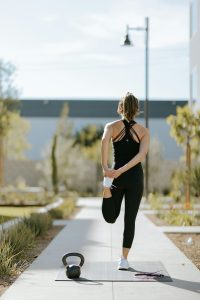
This is a question that comes up a lot and the answer is – both! BUT it is a different type of stretching we need to do.
The purpose of stretching before exercise is to help prevent injury by lengthening the muscles and tendons, to help increase our range of movement.
This type of stretching is done in the form of ‘dynamic movements’ – so movements performed such as hip lifts, ankle circles, shoulder rolls, overhead presses (pushing our arms up to the ceiling) etc. Here we are warming up the muscles ready for a workout.
After exercise stretching is done to aid the repair and recovery of the muscles and tendons, helping to prevent tight muscles and delayed onset muscle soreness (DOMS) that can come after strenuous exercise.
This is where we hold our stretches to gently lengthen the muscles, easing into the stretch. This is what we call ‘static stretches’. These should never be done when the muscles are ‘cold’ so always do these stretches after movement.
When you stretch at the end of your workout, as well as cooling down first, this will help to rid waste products from the muscles, prevent blood pooling and promote the delivery of oxygen and nutrients to the muscles.
Stretching should never hurt!
Whether stretching before or after exercise, never take a stretch to the point where it feels painful. Stretching should be relaxing and stretch only to the point of tension, not past that. Overstretching could cause injury.
How long should I stretch?
Research shows that the optimum time to hold each stretch for is 30 seconds. However, stretches can be held for 60 secs and more if it is comfortable. For a lot of people, 30 seconds is a lot to start with so I normally advise to start off with 10-15 seconds and slowly build it up as your flexibility improves.
While static stretching is done after exercise rather than before, it is okay to do static stretching throughout the day. For instance, if you are working at a computer and your shoulders feel tight. But remember your muscles should be warm – so I don’t advise doing static stretches as soon as you wake up!
Most of all, make stretching a habit and enjoy!
- There are forms of exercise that incorporate the body being in a relaxed fluid state throughout such as Yoga and Tai Chi. Here, as we are constantly keeping the body in a soft, relaxed state during the exercise, we do not need to perform static stretches afterwards. If we are running, or lifting weights etc where we are contracting and relaxing the muscles throughout, this is where static stretching afterwards is beneficial and necessary.
Zoe
